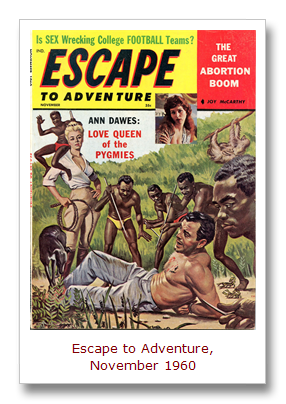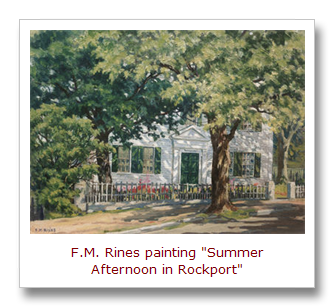Men’s adventure magazines did not create the subgenres of stories about “white queens” and “white kings” who rule some benighted group of “natives” in a jungle, on an island, or in some other exotic locale.
They are themes that goes back at least to the 1800s in British and American fiction. One famous example is H. Rider Haggard’s novel She, a story about the immortal white queen of a Central African tribe, which was first published in 1887.
Like their prewar pulp magazine forbears, men’s post-WWII adventure magazines continued and embellished this tradition in the 20th Century.
In some cases, they took the “white queen” or “white king” concept to new, politically incorrect “heights” — or in the case of today’s featured tale, now lows.
The story “ANN DAWES: LOVE QUEEN of the PYGMIES,” published in the November 1960 issue of Escape to Adventure magazine, has something to offend everyone.
It’s racist, misogynistic and offensive to Africans and little people. It’s also spiced with scenes that include, sex, voyeurism, bondage, torture and hallucinogenic drugs.
Of course, if you’re able to enjoy this kind of campy, kitschy relic of American pop culture, it’s a real hoot to read.
For example, here’s how the “Love Queen” makes her first appearance in the story, which was written by “Julian Blalock” (probably a pseudonym):
“Be quiet, she comes, the tall white goddess approaches. Madami comes!” the dwarf warrior said.
A rigid look of fear tinctured with awe flitted across the wrinkled doll faces of the warriors. Fred Wheeler heard the crackle of brush and twigs underfoot. Into the clearing stepped a white woman in riding boots and an open-necked white shirt. She carried a whip made from plaited monkey skin.
Perched on her shoulder was a tiny ebony man who laughed and made fierce faces at the other natives who barely came up to her waist. He was M’pundu, the shenzi – a magician – and something of a privileged character because of his sleight-of-hand and self-proclaimed powers.
The girl who carried him was Ann Dawes. In the entire blood-spattered saga of Africa, no despot was capable of greater cruelty than was this fair-haired daughter of a Scottish clergyman who ruled the Ituri Forest pygmies for several years at the beginning of this century.
Among other things, Anne is into male bondage and torture. Her latest victim is the hapless white manly man in the story, a Canadian journalist. To ensure that he’ll be in the right mood for what she has in mind, she gives him her special blend of local psychedelic herbs. Interestingly, this 1960 story — published half a decade before the hippie era and the San Francisco “acid tests” began — specifically describes the effects as being like LSD:
“Fawzi! Bring the white bwana our sacred Bolozi drink.”
…Wheeler sniffed the gourd tiny Fawzi held up to his lips. He thought he detected ginger, goat’s milk, acacia leaves, musk and a strange acrid odor. The white man made a wry face. Then he saw the spearmen edge closer and hastily swallowed the concoction…
Like today’s wonder drug, lycergic acid, the fermented drink caused a riot of colors to float in his brain…strange geometric figures and designs writhed in his skull.”
I won’t tell you what happens next. But I’ll let you read it yourself, by clicking here to download the story in PDF format via Payloadz.
The PDF also includes the wild cover. The cover artist is not credited in the magazine. However, in the cover’s lower right corner, next to the scorpions, you can see the small, blocky initials “F.M.”
I believe that’s the partial signature of American illustrator Frank M. Rines (1892-1962). If you look at some of his fine art paintings, like the one at right, you’ll see a very similar looking “F.M” in his full signature (at lower left in the painting). And, the brushwork looks similar to me as well.
Rines is best known for his landscape paintings, as well as for illustrations he did for mainstream magazines and advertisements in the Fifties and Sixties.
He also wrote a number of booksabout drawing and painting that feature his work, including Landscape Drawing with Pencil, How to Draw with Pen, Brush and Ink, and How to Draw Trees.
If the politically incorrect cover of the November 1960 issue of Escape to Adventure was not painted by Rines and his descendants are aghast that I even suggested it, I’ll apologize.
But I think I’m right. And, it doesn’t surprise me that Rines may have dabbled in men’s pulp mag art. As I’ve noted in previous posts, many top notch artists and writers provided work for men’s adventure magazines, especially in the late 1950s and early 1960s.
The “Love Queen of the Pygmies” cover may not have been the best painting F.M. Rines ever did. But it may be the wildest.



